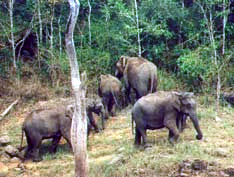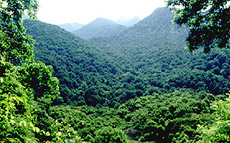located in central Kerala,Thekkadi is a popular hill station and a wildlife centre. This town, which is an important plantation centre, conjures up images of elephants, unending chains of hills and spice scented plantations.
In the Periyar Forest of Thekkadi is one of the finest wildlife reserves of India and spread across the entire district are picturesque plantations and hill towns that hold immense opportunities for treks and mountain walks. The Periyar Wildlife Sanctuary offers a fairly good chance of seeing the great Indian tiger in its natural habitat.
Mangala devi temple
The ancient temple is located 15 kms from Thekkady. It lies hidden in the dense woods at the top of a peak 1337 m above sea level.
The temple is built in the traditional Kerala style of architecture. Visitors are allowed here only on the Chithra Pournami festival day.
The peak commands a panoramic view of the eastern slopes of the ghats and some hill villages of Tamil Nadu. Permission to visit the area can be obtained from the Wildlife Warden, Thekkady.
Kumily
 This plantation town, closely associated with Thekkady, is situated on the outskirts of the Periyar Sanctuary. It is an important shopping centre and spice trade centre, the main bus station and most of the medium range accommodation in the Periyar region is in Kumily.
This plantation town, closely associated with Thekkady, is situated on the outskirts of the Periyar Sanctuary. It is an important shopping centre and spice trade centre, the main bus station and most of the medium range accommodation in the Periyar region is in Kumily.
Murikkady
Washed in fresh spice scented air, Murikkady is a panorama of cardamom, coffee and pepper plantations.
Pandikuzhi
This picturesque place is cradled between Chellarkovil and the Tamil Nadu State border is a popular picnic spot. Pandikuzhi offers great opportunities for trekking and is a photographer`s delight.
Pullumedu
The winding journey to this hill town, along the Periyar river, offers a stunning view of the rolling hills draped in lush greenery. Velvet lawns, rare flora and fauna add to the beauty of Pullumedu, which can be accessed from a jeep.
 Vandanmedu
Vandanmedu
This is one of the world`s largest auction centres for Cardamom. A walk through the sprawling cardamom plantaions of Vandanmedu is a pleasent experience.
Vandiperiyar
The river Periyar flowing through the centre of this town nourishes its vast tea, coffee and pepper plantations. A major trade centre, Vandiperiyar is also home to a number of tea factories. The Government Agriculture Farm and Flower Gardens have a delightful array of rose plants, orchids and anthurium.



















